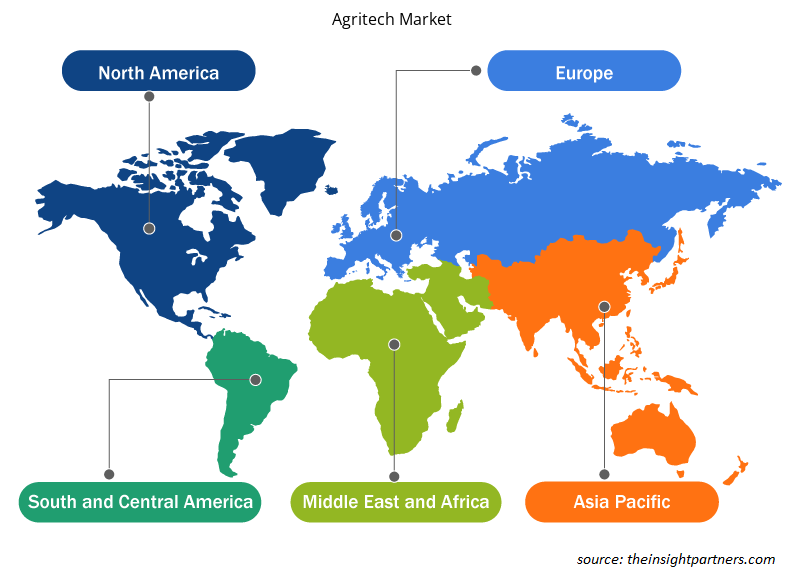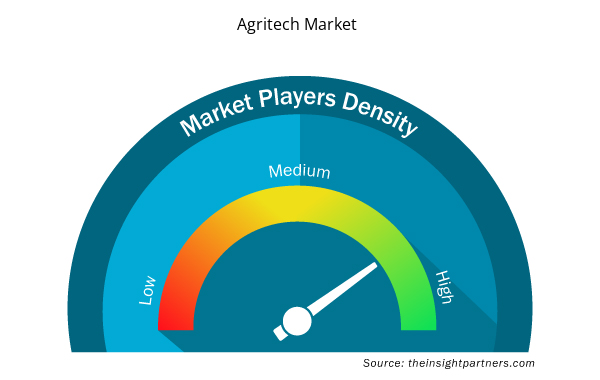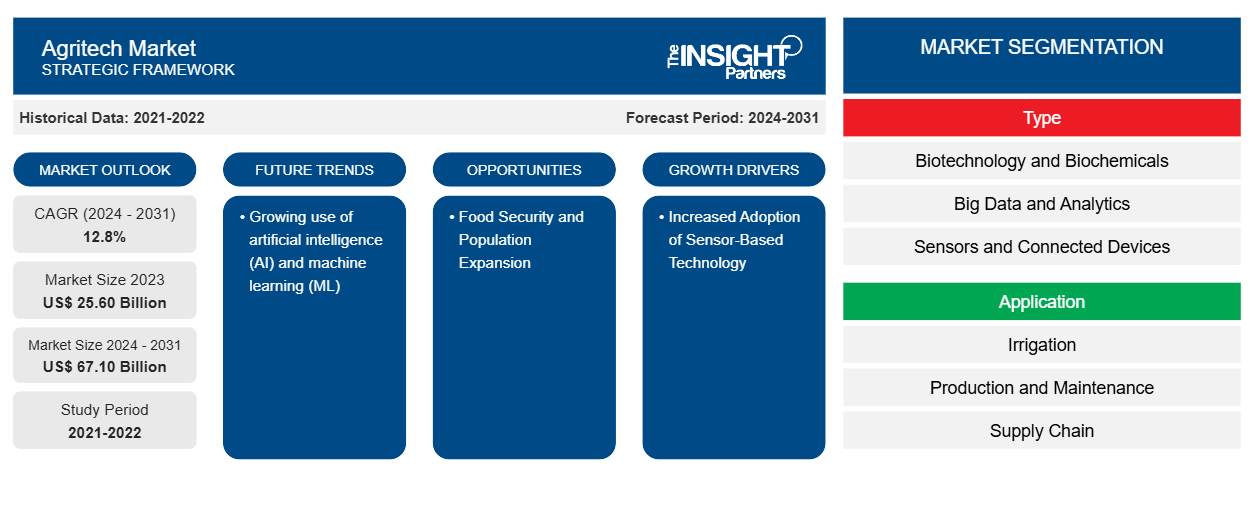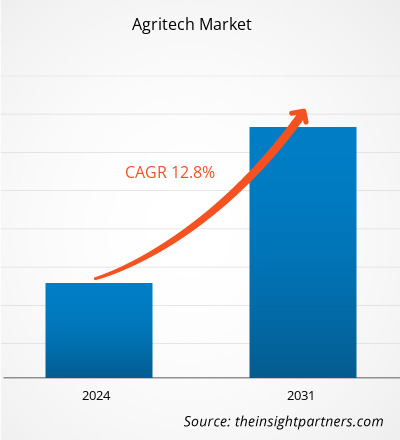من المتوقع أن ينمو حجم سوق التكنولوجيا الزراعية العالمية من 25.60 مليار دولار أمريكي في عام 2023 إلى 67.10 مليار دولار أمريكي بحلول عام 2031؛ ومن المتوقع أن يتوسع بمعدل نمو سنوي مركب قدره 12.8٪ من عام 2024 إلى عام 2031. ومن المرجح أن يظل الاستخدام المتزايد للذكاء الاصطناعي والتعلم الآلي من الاتجاهات الرئيسية في سوق التكنولوجيا الزراعية.
تحليل سوق التكنولوجيا الزراعية
يعد اعتماد التكنولوجيا الزراعية القائمة على المستشعرات، إلى جانب العدد المتزايد من الشركات الناشئة في مجال التكنولوجيا الزراعية، عاملاً رئيسيًا في دفع نمو سوق التكنولوجيا الزراعية.
نظرة عامة على سوق التكنولوجيا الزراعية
تشير التكنولوجيا الزراعية إلى تطبيق الاختراقات التقنية في الزراعة لتحسين الإنتاجية والكفاءة والربحية. يتضمن ذلك الاستفادة من التكنولوجيا لتسريع الزراعة وتطوير المحاصيل التي تزدهر في مجموعة متنوعة من البيئات والحصاد . يمكن أن يشير أيضًا إلى استخدام الروبوتات أو البيانات الضخمة أو الذكاء الاصطناعي أو أي وسيلة أخرى ضرورية لمعالجة المشكلات التي تواجهها الأعمال الزراعية. علاوة على ذلك، يتم استخدام التكنولوجيا الزراعية لإنشاء برامج متطورة تعتمد على إنترنت الأشياء يمكنها تتبع وتقديم معلومات دقيقة حول الطقس وجودة التربة والحالة الحالية. يتم استخدام تقنيات إنترنت الأشياء في الزراعة لتحسين الزراعة دون استنفاد موارد المزارعين أو وقتهم، من خلال تزويدهم بمعلومات في الوقت الفعلي عن محاصيلهم ومزارعهم.
قم بتخصيص هذا التقرير ليناسب متطلباتك
ستحصل على تخصيص لأي تقرير - مجانًا - بما في ذلك أجزاء من هذا التقرير، أو تحليل على مستوى الدولة، وحزمة بيانات Excel، بالإضافة إلى الاستفادة من العروض والخصومات الرائعة للشركات الناشئة والجامعات
- احصل على أهم اتجاهات السوق الرئيسية لهذا التقرير.ستتضمن هذه العينة المجانية تحليلاً للبيانات، بدءًا من اتجاهات السوق وحتى التقديرات والتوقعات.
محركات وفرص سوق التكنولوجيا الزراعية
زيادة استخدام التكنولوجيا القائمة على المستشعرات لصالح السوق
إن الاستخدام المتزايد للتقنيات القائمة على أجهزة الاستشعار يغذي الإنفاق التكنولوجي في صناعة التكنولوجيا الزراعية. وهذا ينطوي على الاستفادة من أجهزة الاستشعار وتكنولوجيا إنترنت الأشياء . تمكن هذه التقنيات المزارعين من جمع البيانات حول مجموعة متنوعة من المعلمات، بما في ذلك أنماط الطقس وظروف التربة وأداء المحاصيل، مما يسمح لهم باتخاذ قرارات أكثر تعليماً. توفر أجهزة الاستشعار الموضوعة في الحقول للمزارعين معلومات في الوقت الفعلي عن رطوبة التربة ودرجة حرارتها وحموضتها. تمكن هذه المعلومات المزارعين من اتخاذ قرارات سريعة بشأن الري وتوصيل النيتروجين وحماية المحاصيل.
الأمن الغذائي والتوسع السكاني
إن النمو السكاني يفرض ضغوطاً على شبكة إمدادات الغذاء العالمية. وتحاول التكنولوجيا الزراعية تلبية الاحتياجات الغذائية للسكان المتزايدين. ويتم تمكين الزراعة والحصاد الدقيقين من خلال تقنيات مثل الطائرات بدون طيار والجرارات الموجهة بنظام تحديد المواقع العالمي، والتي تعمل على تقليل تكاليف المدخلات والتأثير البيئي. وعلاوة على ذلك، توفر الحلول القائمة على البيانات للمزارعين رؤى قيمة حول أنماط الطقس وظروف التربة وأداء المحاصيل، مما يسمح لهم باتخاذ قرارات مدروسة.
تحليل تجزئة تقرير سوق التكنولوجيا الزراعية
إن القطاعات الرئيسية التي ساهمت في استخلاص تحليل سوق التكنولوجيا الزراعية هي النوع والتطبيق.
- بناءً على النوع، ينقسم السوق إلى التكنولوجيا الحيوية والكيمياء الحيوية، والبيانات الضخمة والتحليلات، وأجهزة الاستشعار والأجهزة المتصلة، والتنقل، وغيرها. احتل قطاع التكنولوجيا الحيوية والكيمياء الحيوية حصة سوقية أكبر في عام 2023.
- من حيث التطبيق، ينقسم السوق إلى الري والإنتاج والصيانة وسلسلة التوريد والسوق. احتل قطاع الإنتاج والصيانة حصة سوقية أكبر في عام 2023.
تحليل حصة سوق التكنولوجيا الزراعية حسب المنطقة الجغرافية
ينقسم النطاق الجغرافي لتقرير سوق التكنولوجيا الزراعية بشكل أساسي إلى خمس مناطق: أمريكا الشمالية، ومنطقة آسيا والمحيط الهادئ، وأوروبا، والشرق الأوسط وأفريقيا، وأمريكا الجنوبية/أمريكا الجنوبية والوسطى. سيطرت أمريكا الشمالية على سوق التكنولوجيا الزراعية في عام 2023. ويمكن أن يُعزى نمو السوق الإقليمية إلى التبني المتزايد للزراعة الدقيقة. تم اعتماد تكنولوجيا الزراعة الدقيقة، مثل الطائرات بدون طيار، والأنظمة القائمة على المستشعرات، والجرارات الموجهة بنظام تحديد المواقع العالمي (GPS)، على نطاق واسع في أمريكا الشمالية. تتيح هذه التكنولوجيا للمزارعين زيادة غلة المحاصيل، وخفض تكاليف المدخلات، وتحسين الإنتاجية الإجمالية للمزارع. لقد أحدثت تقنيات الزراعة الدقيقة، بما في ذلك الطائرات بدون طيار، والأنظمة القائمة على المستشعرات، والجرارات الموجهة بنظام تحديد المواقع العالمي (GPS)، ثورة في صناعة الزراعة. من خلال الاستفادة من هذه التقنيات، يمكن للمزارعين تحقيق كفاءة وإنتاجية أكبر في عملياتهم.
رؤى إقليمية حول سوق التكنولوجيا الزراعية
لقد قام المحللون في Insight Partners بشرح الاتجاهات والعوامل الإقليمية المؤثرة على سوق التكنولوجيا الزراعية طوال فترة التوقعات بشكل شامل. يناقش هذا القسم أيضًا قطاعات سوق التكنولوجيا الزراعية والجغرافيا في جميع أنحاء أمريكا الشمالية وأوروبا ومنطقة آسيا والمحيط الهادئ والشرق الأوسط وأفريقيا وأمريكا الجنوبية والوسطى.

- احصل على البيانات الإقليمية المحددة لسوق التكنولوجيا الزراعية
نطاق تقرير سوق التكنولوجيا الزراعية
| سمة التقرير | تفاصيل |
|---|---|
| حجم السوق في عام 2023 | 25.60 مليار دولار أمريكي |
| حجم السوق بحلول عام 2031 | 67.10 مليار دولار أمريكي |
| معدل النمو السنوي المركب العالمي (2024 - 2031) | 12.8% |
| البيانات التاريخية | 2021-2022 |
| فترة التنبؤ | 2024-2031 |
| القطاعات المغطاة | حسب النوع
|
| المناطق والدول المغطاة | أمريكا الشمالية
|
| قادة السوق وملفات تعريف الشركات الرئيسية |
|
كثافة اللاعبين في السوق: فهم تأثيرها على ديناميكيات الأعمال
يشهد سوق التكنولوجيا الزراعية نموًا سريعًا، مدفوعًا بالطلب المتزايد من جانب المستخدم النهائي بسبب عوامل مثل تفضيلات المستهلكين المتطورة والتقدم التكنولوجي والوعي المتزايد بفوائد المنتج. ومع ارتفاع الطلب، تعمل الشركات على توسيع عروضها والابتكار لتلبية احتياجات المستهلكين والاستفادة من الاتجاهات الناشئة، مما يؤدي إلى زيادة نمو السوق.
تشير كثافة اللاعبين في السوق إلى توزيع الشركات أو المؤسسات العاملة في سوق أو صناعة معينة. وهي تشير إلى عدد المنافسين (اللاعبين في السوق) الموجودين في مساحة سوق معينة نسبة إلى حجمها أو قيمتها السوقية الإجمالية.
الشركات الرئيسية العاملة في سوق التكنولوجيا الزراعية هي:
- ار اس ار تيك
- أيرو فارمز
- شركة أبولو للزراعة
- شركة كروفارم للمنتجات الزراعية المحدودة
- كونسيرفيس
- شركة إنديغو الزراعية
إخلاء المسؤولية : الشركات المذكورة أعلاه ليست مرتبة بأي ترتيب معين.

- احصل على نظرة عامة على أهم اللاعبين الرئيسيين في سوق Agritech
أخبار سوق التكنولوجيا الزراعية والتطورات الأخيرة
يتم تقييم سوق التكنولوجيا الزراعية من خلال جمع البيانات النوعية والكمية بعد البحث الأولي والثانوي، والتي تتضمن منشورات الشركات المهمة وبيانات الجمعيات وقواعد البيانات. فيما يلي قائمة بالتطورات في السوق:
- في يناير 2024، حصلت شركة أبولو للزراعة، وهي منصة زراعية تجارية تساعد المزارعين الصغار على تعظيم أرباحهم، على تمويل بقيمة 10 ملايين دولار أمريكي لدعم نموها المستمر. توفر الشركة الناشئة الكينية، التي تأسست في عام 2019، للمزارعين إمكانية الوصول إلى التمويل ومدخلات زراعية عالية الجودة والتأمين والمشورة المحسنة لزيادة ربحيتهم. سيمكن التمويل الأخير شركة أبولو للزراعة من توسيع عملياتها في كينيا ومساعدة المزيد من المزارعين على الازدهار والتكيف مع تغير المناخ والمساهمة في الأمن الغذائي.
(المصدر: شركة أبولو للزراعة، بيان صحفي، 2024)
- في فبراير 2023، قدمت شركة AeroFarms، وهي شركة معتمدة من فئة B ورائدة عالميًا في مجال الزراعة العمودية الداخلية، أحدث مزرعة عمودية داخلية متطورة، AeroFarms AgX. تركز هذه المنشأة المتطورة على البحث والتطوير المبتكر وتقع في الإمارات العربية المتحدة، وتحديدًا في أبو ظبي. تهدف AeroFarms AgX إلى تعزيز الزراعة المستدامة في البيئة الخاضعة للرقابة والزراعة العمودية الداخلية لمعالجة تحديات سلسلة التوريد الزراعية العالمية الأوسع.
(المصدر: AeroFarms، بيان صحفي، 2023)
تغطية تقرير سوق التكنولوجيا الزراعية والمنتجات النهائية
يوفر تقرير "حجم سوق التكنولوجيا الزراعية والتوقعات (2021-2031)" تحليلاً مفصلاً للسوق يغطي المجالات التالية:
- حجم السوق والتوقعات على المستويات العالمية والإقليمية والوطنية لجميع قطاعات السوق الرئيسية التي يغطيها النطاق
- ديناميكيات السوق مثل المحركات والقيود والفرص الرئيسية
- الاتجاهات المستقبلية الرئيسية
- تحليل مفصل لقوى PEST/Porter الخمس وSWOT
- تحليل السوق العالمي والإقليمي الذي يغطي اتجاهات السوق الرئيسية واللاعبين الرئيسيين واللوائح والتطورات الأخيرة في السوق
- تحليل المشهد الصناعي والمنافسة الذي يغطي تركيز السوق، وتحليل خريطة الحرارة، واللاعبين البارزين، والتطورات الأخيرة
- ملفات تعريف الشركة التفصيلية
- التحليل التاريخي (سنتان)، السنة الأساسية، التوقعات (7 سنوات) مع معدل النمو السنوي المركب
- تحليل PEST و SWOT
- حجم السوق والقيمة / الحجم - عالميًا وإقليميًا وقطريًا
- الصناعة والمنافسة
- مجموعة بيانات Excel



Report Coverage
Revenue forecast, Company Analysis, Industry landscape, Growth factors, and Trends

Segment Covered
This text is related
to segments covered.

Regional Scope
North America, Europe, Asia Pacific, Middle East & Africa, South & Central America

Country Scope
This text is related
to country scope.
الأسئلة الشائعة
The global agritech market is expected to reach US$ 67.10 billion by 2031.
The key players holding the majority of shares in the global agritech market are ARSR Tech, AeroFarms, Apollo Agriculture, Crofarm Agriproducts Pvt Ltd, and Conservis.
The growing use of artificial intelligence (AI) and machine learning (ML) is likely to remain a key agritech market trends.
The greater adoption of sensor-based technology, along with the rising number of agritech startups, is a major factor driving the agritech market growth.
The agritech market size is expected to grow from US$ 25.60 billion in 2023 to US$ 67.10 billion by 2031; it is anticipated to expand at a CAGR of 12.8% from 2024 to 2031.
Trends and growth analysis reports related to Technology, Media and Telecommunications : READ MORE..
The Insight Partners performs research in 4 major stages: Data Collection & Secondary Research, Primary Research, Data Analysis and Data Triangulation & Final Review.
- Data Collection and Secondary Research:
As a market research and consulting firm operating from a decade, we have published and advised several client across the globe. First step for any study will start with an assessment of currently available data and insights from existing reports. Further, historical and current market information is collected from Investor Presentations, Annual Reports, SEC Filings, etc., and other information related to company’s performance and market positioning are gathered from Paid Databases (Factiva, Hoovers, and Reuters) and various other publications available in public domain.
Several associations trade associates, technical forums, institutes, societies and organization are accessed to gain technical as well as market related insights through their publications such as research papers, blogs and press releases related to the studies are referred to get cues about the market. Further, white papers, journals, magazines, and other news articles published in last 3 years are scrutinized and analyzed to understand the current market trends.
- Primary Research:
The primarily interview analysis comprise of data obtained from industry participants interview and answers to survey questions gathered by in-house primary team.
For primary research, interviews are conducted with industry experts/CEOs/Marketing Managers/VPs/Subject Matter Experts from both demand and supply side to get a 360-degree view of the market. The primary team conducts several interviews based on the complexity of the markets to understand the various market trends and dynamics which makes research more credible and precise.
A typical research interview fulfils the following functions:
- Provides first-hand information on the market size, market trends, growth trends, competitive landscape, and outlook
- Validates and strengthens in-house secondary research findings
- Develops the analysis team’s expertise and market understanding
Primary research involves email interactions and telephone interviews for each market, category, segment, and sub-segment across geographies. The participants who typically take part in such a process include, but are not limited to:
- Industry participants: VPs, business development managers, market intelligence managers and national sales managers
- Outside experts: Valuation experts, research analysts and key opinion leaders specializing in the electronics and semiconductor industry.
Below is the breakup of our primary respondents by company, designation, and region:

Once we receive the confirmation from primary research sources or primary respondents, we finalize the base year market estimation and forecast the data as per the macroeconomic and microeconomic factors assessed during data collection.
- Data Analysis:
Once data is validated through both secondary as well as primary respondents, we finalize the market estimations by hypothesis formulation and factor analysis at regional and country level.
- Macro-Economic Factor Analysis:
We analyse macroeconomic indicators such the gross domestic product (GDP), increase in the demand for goods and services across industries, technological advancement, regional economic growth, governmental policies, the influence of COVID-19, PEST analysis, and other aspects. This analysis aids in setting benchmarks for various nations/regions and approximating market splits. Additionally, the general trend of the aforementioned components aid in determining the market's development possibilities.
- Country Level Data:
Various factors that are especially aligned to the country are taken into account to determine the market size for a certain area and country, including the presence of vendors, such as headquarters and offices, the country's GDP, demand patterns, and industry growth. To comprehend the market dynamics for the nation, a number of growth variables, inhibitors, application areas, and current market trends are researched. The aforementioned elements aid in determining the country's overall market's growth potential.
- Company Profile:
The “Table of Contents” is formulated by listing and analyzing more than 25 - 30 companies operating in the market ecosystem across geographies. However, we profile only 10 companies as a standard practice in our syndicate reports. These 10 companies comprise leading, emerging, and regional players. Nonetheless, our analysis is not restricted to the 10 listed companies, we also analyze other companies present in the market to develop a holistic view and understand the prevailing trends. The “Company Profiles” section in the report covers key facts, business description, products & services, financial information, SWOT analysis, and key developments. The financial information presented is extracted from the annual reports and official documents of the publicly listed companies. Upon collecting the information for the sections of respective companies, we verify them via various primary sources and then compile the data in respective company profiles. The company level information helps us in deriving the base number as well as in forecasting the market size.
- Developing Base Number:
Aggregation of sales statistics (2020-2022) and macro-economic factor, and other secondary and primary research insights are utilized to arrive at base number and related market shares for 2022. The data gaps are identified in this step and relevant market data is analyzed, collected from paid primary interviews or databases. On finalizing the base year market size, forecasts are developed on the basis of macro-economic, industry and market growth factors and company level analysis.
- Data Triangulation and Final Review:
The market findings and base year market size calculations are validated from supply as well as demand side. Demand side validations are based on macro-economic factor analysis and benchmarks for respective regions and countries. In case of supply side validations, revenues of major companies are estimated (in case not available) based on industry benchmark, approximate number of employees, product portfolio, and primary interviews revenues are gathered. Further revenue from target product/service segment is assessed to avoid overshooting of market statistics. In case of heavy deviations between supply and demand side values, all thes steps are repeated to achieve synchronization.
We follow an iterative model, wherein we share our research findings with Subject Matter Experts (SME’s) and Key Opinion Leaders (KOLs) until consensus view of the market is not formulated – this model negates any drastic deviation in the opinions of experts. Only validated and universally acceptable research findings are quoted in our reports.
We have important check points that we use to validate our research findings – which we call – data triangulation, where we validate the information, we generate from secondary sources with primary interviews and then we re-validate with our internal data bases and Subject matter experts. This comprehensive model enables us to deliver high quality, reliable data in shortest possible time.


 احصل على عينة مجانية لهذا التقرير
احصل على عينة مجانية لهذا التقرير